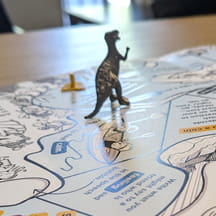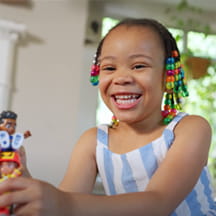For one young hospital patient, it’s the opportunity to meet her favorite TV meteorologist. For others, it’s discovering a passion for art through an interactive, guided painting class. For staff members and hospital visitors, it’s getting to enjoy a Thanksgiving parade.
For the leadership team at Children’s of Alabama, these experiences all reflect the success of its “Making Play Accessible for All Patients” program. “I think if we could just measure the impact by smiles—and we will—we can say for certain that this project has been a huge success,” says Michelle Littleton, CFRE, director of grants and donor relations at Children’s of Alabama in Birmingham.
The program was made possible by the Toy Foundation Play Grant Program—a partnership between Children's Hospital Association and the Toy Foundation, a nonprofit organization that works with the toy industry to provide play opportunities to children across the country. In all, 18 children’s hospitals received grants through the program in 2021 to make play more accessible in children’s hospital settings with the goal of strengthening the overall development of children.
Children’s of Alabama allocated its grant funds toward new cameras and lighting for its on-campus performance area as well as Wi-Fi and closed-circuit television technologies to enable its programs to be beamed live across all departments of the hospital.
Increasing accessibility for everyone
The hospital had regularly presented interactive play and entertainment programs from its performance area each week, but a few years ago they began discussing how they could make those events more accessible for patients who were unable to attend due to their medical conditions. Those conversations accelerated in the wake of COVID-19.
“When COVID happened, everything stopped; suddenly, it wasn’t just certain populations we were focusing on but the entire hospital,” says Honey Cook, child life specialist supervisor at Children’s of Alabama. “It really pushed us to work faster to get this going and has really turned out to be a wonderful experience—the program has met a much larger need than we ever anticipated.”
The technology improvements have enabled Children’s to reach more patients with its in-house programming than ever before—about 100 patients participate in each event, including those visiting the emergency department and in the behavioral health population.
The program has also had a profound impact on the hospital’s staff, according to Littleton. “It was meant to help our patients be creative and play, but it has also provided our child life team the opportunity to be creative with the events,” Littleton says. “This project has given our staff the room to dream big on what's possible with this technology.”
A perfect example is the hospital’s annual Thanksgiving parade, which could only be attended in person before the grant. Now the parade is broadcast live with hospital staffers emceeing the event, resembling the famous Macy’s Thanksgiving Day parade.
“It was really fun for them to have a live broadcast of the parade on CCTV,” Cook says. “The technology has brought new life to a lot of our events and added a new level that the patients have really enjoyed.”
Applications for the 2022-2023 Toy Foundation Play Grants program are being accepted until August 8, 2022.


